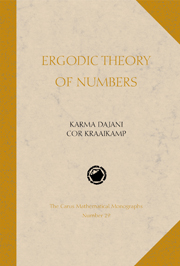Preface
Summary
In this book we will look at the interaction between two fields of mathematics: number theory and ergodic theory (as part of dynamical systems). The subject under study is thus part of what is known in France as Théorie Ergodique des Nombres, and consists of a family of series expansions of numbers in the unit interval [0, 1] with their ‘metrical properties.’ So the questions we want to study are number theoretical in nature, and the answers will be obtained with the help of ergodic theory. That is, we will view these expansions as iterations of an appropriate measure-preserving transformation on [0, 1], which will then be shown to be ergodic. The number-theoretical questions will be reformulated in the language of ergodic theory. What it means to be ergodic, or—in general—what the basic ideas behind ergodic theory entail, will be explained along the way.
This book grew out of a course given in 1996 at George Washington University, Washington, DC, during the Summer Program for Women in Mathematics, sponsored by NSA. Our aim was not to write yet another book on ergodic theory (there are already several outstanding books, most of them mentioned in these pages), but to introduce first-year graduate students to a dynamical way of thinking. Consequently, many classical concepts from ergodic theory are either briefly mentioned, or even left out.
- Type
- Chapter
- Information
- Ergodic Theory of Numbers , pp. ix - xPublisher: Mathematical Association of AmericaPrint publication year: 2002



